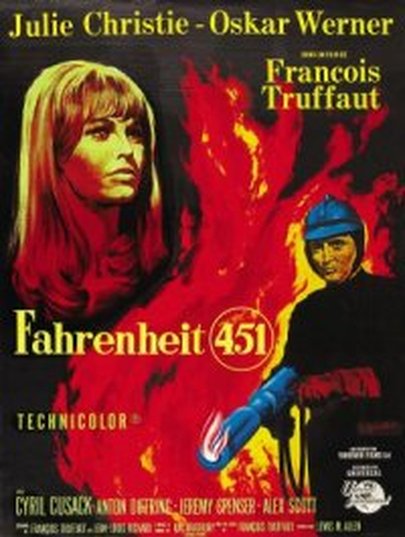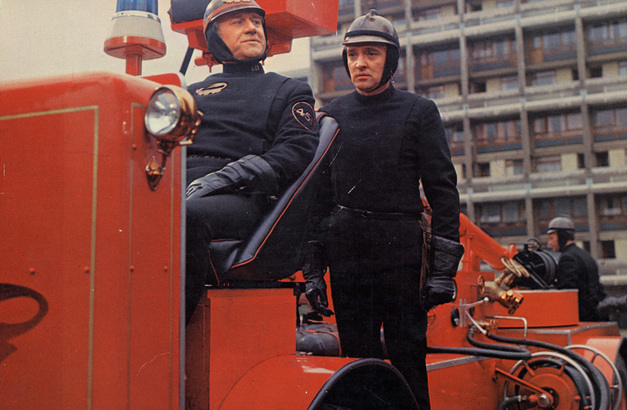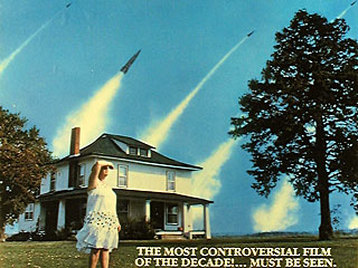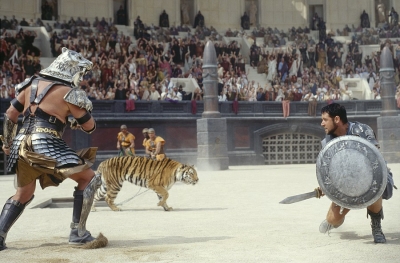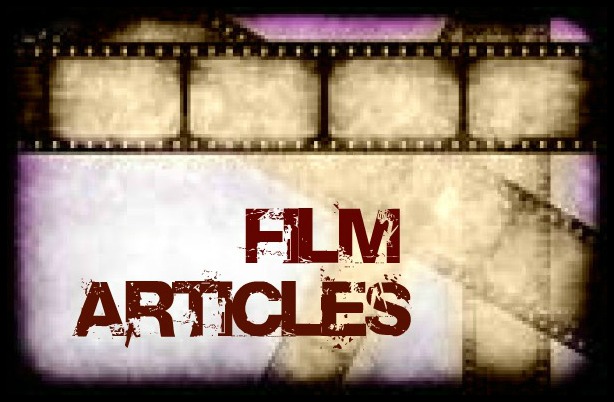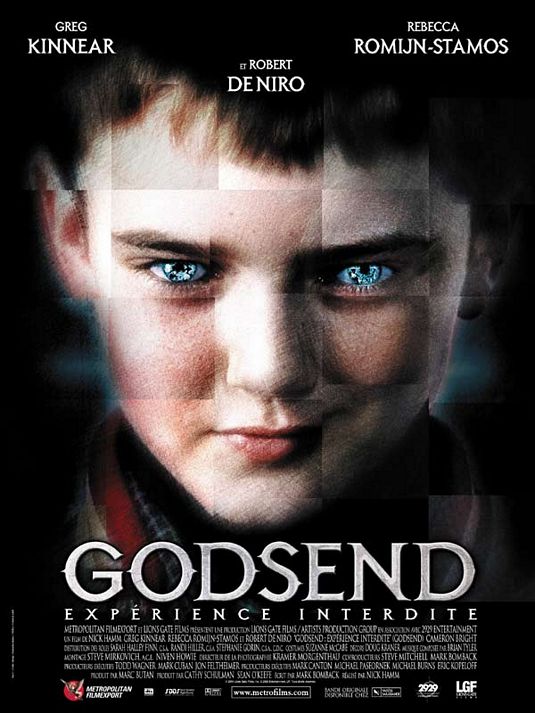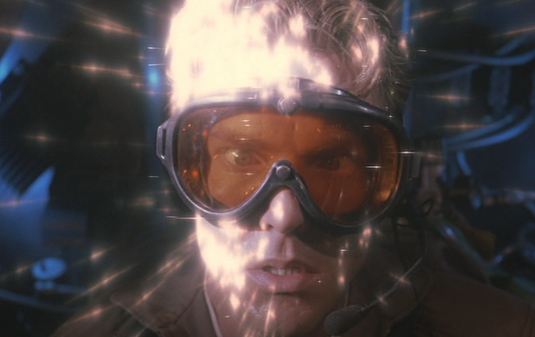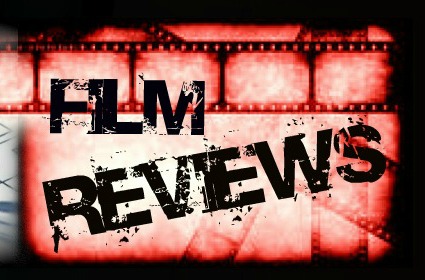Review of Francois Truffaut Film Fahrenheit 451
|
|
FAHRENHEIT 451 (1966)
SLOW BURNER
|
By Tom Clare
Farenheit 451 (1966) Directed by François Truffaut. UK: 12. The 1960s film Fahrenheit 451 carried with it the prospect of an exciting meeting of minds; a story adapted from Ray Bradbury’s excellent fifties dystopian novel of the same name, and directed by the now-legendary French New Wave pioneer François Truffaut (The 400 Blows (1959), Jules and Jim (1962)). The film isn’t as dynamic as this combination may have promised, but it remains an enduringly relevant tale, preserving the book’s warning as to the perils of culture “dumbing down”. Guy Montag (Oskar Werner) is a fireman at an indeterminate time in the future. In Fahrenheit 451, this carries quite different connotations; firemen start fires rather than put them out, wielding flamethrowers and carrying out ritualistic, public book-burnings. Society fears and distrusts books, claiming they spread ‘lies’ about ‘people who never existed’, false philosophy, and stories devised to make people sad, angry and anti-social. One day on the way to work, Montag has the root of a dangerous question planted in his head by free-spirited neighbour Clarisse (Julie Christie) – ‘why?’ Are books harmful, has he read them, why does he burn them? |
Soon he begins to question the ethics not only of his job, but more broadly the nanny state within which his, and everyone else’s, lives are so tightly dictated.
The first half of Bradbury’s tale is intelligently reconstructed. The viewer is on the periphery of a fascinating world; an unseen yet omnipotent controlled authoritarian society with odd quirks and contradictions that few living within it challenge or even seem aware of. Its dystopian suburbia is attractive and impressively realised; marking the prosperous locales with vivid colour and defining the city outskirts with stark, brutal architecture; it acts as a precursor to A Clockwork Orange’s more visceral, violent vision of the future – which is praise in itself. The director exercised some artistic license on the picture, most evident in his brave move to cast Julie Christie as both Montag’s neighbour Clarisse, and his wife, Linda.
The two are diametric opposites, and one critic’s suggestion that the two differ little more than in the changing of the actress’s hair-do is perhaps a little unfair. Books come to represent imagination and curiosity, and by openly rejecting both, Linda is the perfect unassuming zombie, to be easily manipulated. Her hazy, shallow demeanour and materialistic nature are effectively conveyed by the actress, whilst the beige/brown outfits, walls and furnishings she’s enveloped by hint at her utter conformity and humdrum existence. She symbolises a great irony that is not lost on Truffaut; the criticism of books being seen as anti-social and subversive tools is continually undermined by Linda being glued to television sets around her house, or taking massive quantities of drugs.
Perhaps the film’s deftest scene is a delivered with a rare dash of humour. Linda believes she’s been selected to star in one of the television shows she’s so hooked on. The characters on screen come up with a dilemma, then direct a question at her (or as Montag more accurately proposes, anyone and everyone called Linda), but before she is able to reply with anything more than a mumble, they claim that she is right and plough on, bringing to light, in a quietly jovial moment, the absurd illusion of an individual’s value.
CHRISTIES: TWO FOR THE PRICE OF ONE
Julie Christie cuts a more chirpy and likable, though perhaps less distinctive figure in Clarisse. The character’s role is reshaped to appear more film-friendly, whereas in the book she’s more of a muse than a mistress, her participation less involved, her fate rather more ambiguous. The dual-casting points to Clarisse as a ‘thinking’ version of Linda, or perhaps the wife Montag wishes he had. Christie’s performances won’t live long in the memory, though for what it’s worth, she juggles her two relatively unchallenging roles without major incident.
The first half of Bradbury’s tale is intelligently reconstructed. The viewer is on the periphery of a fascinating world; an unseen yet omnipotent controlled authoritarian society with odd quirks and contradictions that few living within it challenge or even seem aware of. Its dystopian suburbia is attractive and impressively realised; marking the prosperous locales with vivid colour and defining the city outskirts with stark, brutal architecture; it acts as a precursor to A Clockwork Orange’s more visceral, violent vision of the future – which is praise in itself. The director exercised some artistic license on the picture, most evident in his brave move to cast Julie Christie as both Montag’s neighbour Clarisse, and his wife, Linda.
The two are diametric opposites, and one critic’s suggestion that the two differ little more than in the changing of the actress’s hair-do is perhaps a little unfair. Books come to represent imagination and curiosity, and by openly rejecting both, Linda is the perfect unassuming zombie, to be easily manipulated. Her hazy, shallow demeanour and materialistic nature are effectively conveyed by the actress, whilst the beige/brown outfits, walls and furnishings she’s enveloped by hint at her utter conformity and humdrum existence. She symbolises a great irony that is not lost on Truffaut; the criticism of books being seen as anti-social and subversive tools is continually undermined by Linda being glued to television sets around her house, or taking massive quantities of drugs.
Perhaps the film’s deftest scene is a delivered with a rare dash of humour. Linda believes she’s been selected to star in one of the television shows she’s so hooked on. The characters on screen come up with a dilemma, then direct a question at her (or as Montag more accurately proposes, anyone and everyone called Linda), but before she is able to reply with anything more than a mumble, they claim that she is right and plough on, bringing to light, in a quietly jovial moment, the absurd illusion of an individual’s value.
CHRISTIES: TWO FOR THE PRICE OF ONE
Julie Christie cuts a more chirpy and likable, though perhaps less distinctive figure in Clarisse. The character’s role is reshaped to appear more film-friendly, whereas in the book she’s more of a muse than a mistress, her participation less involved, her fate rather more ambiguous. The dual-casting points to Clarisse as a ‘thinking’ version of Linda, or perhaps the wife Montag wishes he had. Christie’s performances won’t live long in the memory, though for what it’s worth, she juggles her two relatively unchallenging roles without major incident.
|
|
|
|
For the musical score, Truffaut enlisted the services of Bernard Herrmann, a long-time collaborator with Alfred Hitchcock. Herrmann reprises the lush, panicky string accompaniment he used to such memorable effect on Psycho, though here the racy tempos seem somewhat ill-fitting. A subtler, more invasive sound would have fit the cerebral atmosphere more aptly.
The closing stages of the novel made for some breathlessly tense action but in the film such sequences are disappointingly brief and incidental. Attempts at a poignant and poetic ending also fall flat, even with a clever instance of Cinéma vérité showing a child struggle to commit a book to memory as an older, dying man recites it to him. Dialogue is inconsistent, perhaps in part due to Truffaut’s limited grasp of English and apparent unhappiness with stony-faced Viennese actor Oskar Werner over his interpretation of Montag. Werner is fine playing the “unthinking automaton” in the beginning, but slightly less reliable when shows of emotional instability are called for later on – there’s no question, he paints a much more muted figure than the book.
Montag’s Captain, played by the very watchable Cyril Cusack, gets to spout some of the best and most (if you’ll pardon the pun) inflammatory dialogue, as he positively delights in rambling about the worthlessness of literature and how people are drawn to fire. Many of the monologues from other characters lack clout however, appearing listless and preachy rather than inspirational, with some rather hammy tertiary performances. The film is also guilty of becoming hypnotised by its own martyr-like book burning scenes, developing a rather heavy reliance on close-up shots of classic works receiving the flaming treatment.
Fahrenheit 451 ultimately does no disgrace to its source material but, in a somewhat ironic twist, comes to highlight its own theme of written literature proving a more articulate medium to that of the screen. Middling performances from its leading lights, along with an inability to graft out a punchy, meaningful ending mean it comes off second best, yet Truffaut’s elaborate sets and at times beautiful compositions remain a highlight. So poignant is the story, that even now it’s difficult not to be in some way moved or disconcerted by the image of history’s works being systematically eradicated. Dare I sum it up thus…Worth watching, but it’s not as good as the book!
The closing stages of the novel made for some breathlessly tense action but in the film such sequences are disappointingly brief and incidental. Attempts at a poignant and poetic ending also fall flat, even with a clever instance of Cinéma vérité showing a child struggle to commit a book to memory as an older, dying man recites it to him. Dialogue is inconsistent, perhaps in part due to Truffaut’s limited grasp of English and apparent unhappiness with stony-faced Viennese actor Oskar Werner over his interpretation of Montag. Werner is fine playing the “unthinking automaton” in the beginning, but slightly less reliable when shows of emotional instability are called for later on – there’s no question, he paints a much more muted figure than the book.
Montag’s Captain, played by the very watchable Cyril Cusack, gets to spout some of the best and most (if you’ll pardon the pun) inflammatory dialogue, as he positively delights in rambling about the worthlessness of literature and how people are drawn to fire. Many of the monologues from other characters lack clout however, appearing listless and preachy rather than inspirational, with some rather hammy tertiary performances. The film is also guilty of becoming hypnotised by its own martyr-like book burning scenes, developing a rather heavy reliance on close-up shots of classic works receiving the flaming treatment.
Fahrenheit 451 ultimately does no disgrace to its source material but, in a somewhat ironic twist, comes to highlight its own theme of written literature proving a more articulate medium to that of the screen. Middling performances from its leading lights, along with an inability to graft out a punchy, meaningful ending mean it comes off second best, yet Truffaut’s elaborate sets and at times beautiful compositions remain a highlight. So poignant is the story, that even now it’s difficult not to be in some way moved or disconcerted by the image of history’s works being systematically eradicated. Dare I sum it up thus…Worth watching, but it’s not as good as the book!
|
|
|
|
Want to know more about FAHRENHEIT 451?
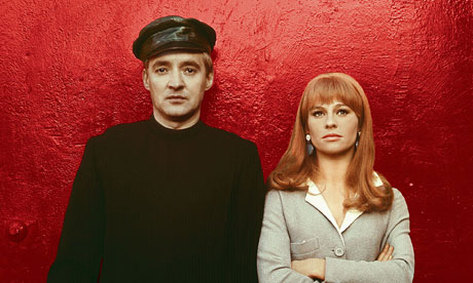
BURNING THE BOOK ONTO FILM
AUTHORITY, TECHNOLOGY AND HISTORICAL CONTEXT: ADAPTING THE BOOK AND MARKETING THE FILM
The mid twentieth century witnessed a wave of fictional social criticism first expressed in books, then transferred on to film. Fahrenheit 451 has continued to be popular alongside other works of the genre such as 1984 and Brave New World.
AUTHORITY, TECHNOLOGY AND HISTORICAL CONTEXT: ADAPTING THE BOOK AND MARKETING THE FILM
The mid twentieth century witnessed a wave of fictional social criticism first expressed in books, then transferred on to film. Fahrenheit 451 has continued to be popular alongside other works of the genre such as 1984 and Brave New World.
|
|

